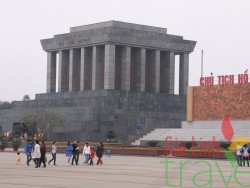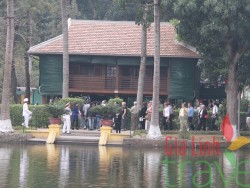Ho Chi Minh Mausoleum
The Ho Chi Minh Mausoleum Area


House on stilts

The Ho Chi Minh Mausoleum Area
The Ho Chi Minh Mausoleum Area
Within the centre of Hanoi, a large area is dedicated to Ho Chi Minh. The centerpiece is a large mausoleum the place his embalmed physique lies in a bier inside a glass case. Guests must be a part of a queue and file by means of the room without stopping. No photography is allowed, and all private possessions must be overlooked side (provision is made for this).
It’s a macabre experience, however most visitors foreign seem to find strangely shifting, perhaps due to the undisguised reverence of the Vietnamese people present.
The building was erected with help from the United States, and is a good example of Soviet structure of the period. It’s guarded by an honor guard of Vietnamese soldiers in immaculate white dress uniforms who march around the constructing at common intervals.
It’s open from 08.00 to 11.00 from Tuesday to Thursday, and over the weekends
Actually, Uncle Ho, as he’s affectionately identified in Vietnam, left instructions for his cremation in his will. Nonetheless, at the time of his demise in 1969, the yr after the Tet Offensive, the warfare was nonetheless raging and morale was low. Communist Social gathering chiefs recognized his iconic standing and overrode his needs, in all probability a pragmatically smart choice, however ethically reprehensive.
The embalming process was undertaken by Russian consultants – every year in early autumn, his body is flown to Moscow for three months for maintenance.
The grandeur of the mausoleum is a strange contrast to the simple stilt home the place Ho Chi Minh lived and worked. Constructed in the style of ethnic minority dwellings, it overlooks a large carp pond and is a calm sanctuary. Guests can look by the windows to see the austere furnishings and his few private possessions. On his desk every day is a vase of his favorite blossoms, Hoa hue Trang, a sweetly scented flower slightly like a tall white bluebell.
Nearby is the magnificent Presidential Palace, once the palace of the Governor-Common of Indochina in the course of the colonial period. Sadly, it’s not open to the public.
In the wrong way, the Ho Chi Minh Museum gives a complete overview of the person’s life and work and his vision of peace and happiness. It’s informative; however belowstandably overlooks a number of the more risqué episodes in his life. Close by, the well-known One Pillar Pagoda is worth a passing look. Although it’s one of many symbols of Hanoi, its one thing of a disappointment as it’s a modern replica.
The Ho Chi Minh Museum is open from 08.00 to 11.00 and from 13.30 to 16.30 daily.
A brief walk throughout Da Dinh Sq. instantly in front of the mausoleum takes you previous the Tomb of the Unknown Soldier, a stunningly stunning monument especially when illuminated at night. From there, another brief stroll takes you to the Hanoi Citadel.
The location of the traditional Hanoi Citadel has been occupied by the Army for a lot of years. It’s now starting to be turned over to the Hanoi Metropolis authorities in stages. To date, a few impressive pagodas have been restored and made accessible. Not distant, a serious excavation on the location of what will be the new National Meeting constructing has revealed the remains of a substantial palace complicated courting from the Ly Dynasty that ruled a couple of millennium ago. The findings have remodeled knowledge about the early history of Vietnam and its hyperlinks to China.
It has just lately been introduced that the Army will soon hand over the remains of the Citadel’s Forbidden City to the Hanoi’s Individual’s Committee. After restoration work, this too will be open to visitors.
